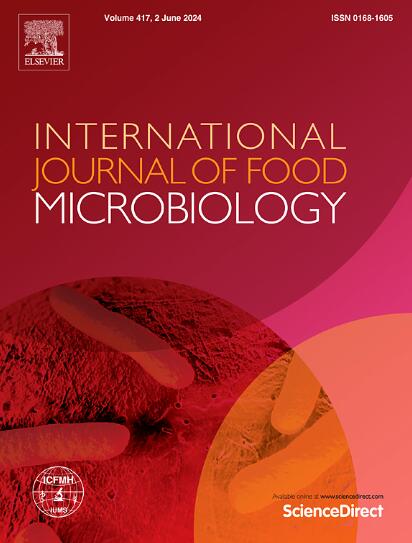Physiological mechanisms and transcriptomic analysis of the disease resistance in pear fruit induced by Debaryomyces hansenii
IF 5
1区 农林科学
Q1 FOOD SCIENCE & TECHNOLOGY
International journal of food microbiology
Pub Date : 2025-07-16
DOI:10.1016/j.ijfoodmicro.2025.111350
引用次数: 0
Abstract
Debaryomyces hansenii, an antagonistic yeast, effectively suppresses postharvest pathogens in various across fruit and vegetable commodities. However, the specific mechanisms underlying its ability to trigger defense responses in pear fruits remain poorly understood. This study investigated the physiological and molecular mechanisms associated with D. hansenii-induced disease resistance in pear fruits. The results showed that D. hansenii significantly inhibited Penicillium expansum, rapidly colonized on wound and surfaces at 20 °C, and competitively excluded pathogens by monopolizing carbon sources and spatial niches. Physiological analyses revealed that D. hansenii enhanced the activity of resistance-related enzymes (Polyphenol oxidase, Phenylalanine ammonia-lyase, and Peroxidase) and increased secondary metabolite content (total phenols and flavonoids) while reducing Malondialdehyde (MDA) levels. Moreover, this yeast induced the activity of antioxidant enzymes (Superoxide dismutase, Catalase, and Ascorbate peroxidase) in pears, which synergistically scavenged reactive oxygen species (ROS) to maintain redox homeostasis. Transcriptomic analysis demonstrated that D. hansenii activates five key pathways, triggering the expression of genes involved in the biosynthesis of defense-related antimicrobial compounds. Additionally, it activates calcium signaling-MAPK-WRKY cascades, thereby upregulating defense-related genes such as PR1. Notably, critical genes (AOS and OPR2) in the jasmonic acid (JA) signaling pathway were significantly upregulated. This study is the first to elucidate the synergistic role of D. hansenii in enhancing postharvest disease resistance in pear fruits through multidimensional mechanisms. This study provides a theoretical foundation for the development of efficient and safe biocontrol technology.
梨果实抗病性的生理机制及转录组学分析
韩氏Debaryomyces hansenii是一种拮抗酵母,可有效抑制各种水果和蔬菜商品中的采后病原体。然而,其在梨果实中引发防御反应的能力的具体机制仍然知之甚少。本研究探讨了汉氏菌诱导梨果实抗病的生理和分子机制。结果表明,在20℃条件下,D. hansenii对扩张青霉具有明显的抑制作用,在伤口和伤口表面迅速定植,并通过垄断碳源和空间生态位对病原菌进行竞争性排斥。生理分析表明,汉桑草提高了抗性相关酶(多酚氧化酶、苯丙氨酸解氨酶和过氧化物酶)的活性,增加了次生代谢物(总酚和类黄酮)含量,降低了丙二醛(MDA)水平。此外,该酵母菌诱导梨中抗氧化酶(超氧化物歧化酶、过氧化氢酶和抗坏血酸过氧化物酶)的活性,协同清除活性氧(ROS),维持氧化还原稳态。转录组学分析表明,D. hansenii激活了5个关键途径,触发了参与防御相关抗菌化合物生物合成的基因的表达。此外,它激活钙信号- mapk - wrky级联反应,从而上调防御相关基因,如PR1。值得注意的是,茉莉酸(jasmonic acid, JA)信号通路中的关键基因(AOS和OPR2)显著上调。本研究首次阐明了汉氏菌通过多角度机制增强梨果实采后抗病性的协同作用。本研究为开发高效、安全的生物防治技术提供了理论基础。
本文章由计算机程序翻译,如有差异,请以英文原文为准。
求助全文
约1分钟内获得全文
求助全文
来源期刊
CiteScore
10.40
自引率
5.60%
发文量
322
审稿时长
65 days
期刊介绍:
The International Journal of Food Microbiology publishes papers dealing with all aspects of food microbiology. Articles must present information that is novel, has high impact and interest, and is of high scientific quality. They should provide scientific or technological advancement in the specific field of interest of the journal and enhance its strong international reputation. Preliminary or confirmatory results as well as contributions not strictly related to food microbiology will not be considered for publication.

 求助内容:
求助内容: 应助结果提醒方式:
应助结果提醒方式:


